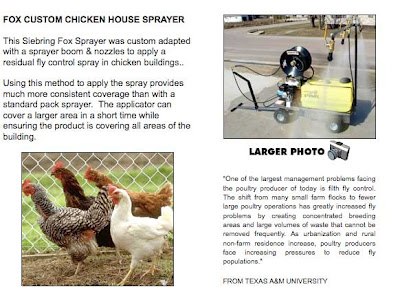
I've been meaning to post about this Star Tribune article since it ran on January 23. From it I learned about Reginaldo Haslett-Marroquin of Northfield, Minnesota, who is working with Mexican immigrant families to build completely solar-heated hoop houses for raising chickens, even during the Minnesota winter. As director of the Rural Enterprise Center, he spends his days working to create "agripreneurs."
As writer Kristin Tillotson describes the hoop house, "It smells not of ammonia from poop, but sweet, clean hay." Humane treatment of the chickens is one part of the larger picture for Haslett-Marroquin, which is, as Tillotson says: "sustainable farming, energy conservation, self-sufficiency for low-income immigrants and healthier food for everyone."
I couldn't help thinking of Haslett-Marroquin and happy chickens when I saw this on a farm and greenhouse products website. It's a description of a liquid-spraying system:
In case you can't read the text at right, this is what it says:
One of the largest management problems facing the poultry producer of today is filth fly control. The shift from many small farm flocks to fewer large poultry operations has greatly increased fly problems by creating concentrated breeding areas and large volumes of waste that cannot be removed frequently. As urbanization and rural non-farm residence increases, poultry producers face increasing pressures to reduce fly populations. FROM TEXAS A&M UNIVERSITYDarn those city people and non-farmers who force farmers to deal with their filth fly problems. It's not like the flies have been proven to be disease vectors or anything.
According to worldpoultry.net, one of the primary insecticides used in a sprayer like this is pyrethrum. (Reading that page is an eye-opener in general.) Pyrethrum is an extract of the chrystanthemum (daisy) plant, which has what's called a "knock down and kill effect" on insects, such as filth flies. It's usually combined with synthetic chemicals that "synergize" with it to make it more effective. (The pyrethrum knocks them down, but it doesn't always kill them, so the synthetic takes care of that. Not how I usually think of synergy happening, but hey.)
As pesticides go, pyrethrum sounds like it's relatively benign: It breaks down quickly and "only" has mildly negative effects on mammals). Of course, it kills every insect it touches, including honeybees, and it's highly toxic to fish and frogs. Since chickens are supposed to be doused to the skin with it, one can only hope they're more like mammals and less like fish.
Along with "enclosed poultry housing," frequent use of sprayers like the one shown here to spread pyrethrum has been shown to lead to pyrethrum-resistant flies (big surprise!). All of those giant chicken houses, where the birds have no room to move and the farmer can't clean up sufficiently, lead to outbreaks of flies that can only be controlled with chemicals, which in turn lead to resistant flies, requiring ever-stronger insecticides.
All this is to say... I wish Reginaldo Haslett-Marroquin the best of luck in building his grassroots, decentralized, solar-heated, chicken coop movement.
Update: Here's an additional story about Haslett-Marroquin's work.


3 comments:
Me, too – his chicken coop looks amazing! Thanks for the post, looking at two very different ways of raising poultry.
I think more people are realizing the cost of "cheap" chicken. I'm hoping for some synergy between growing interest in better food production and nifty ideas like this that make it possible. As an omnivore, I can tell you something: You can really taste the happy.
Post a Comment